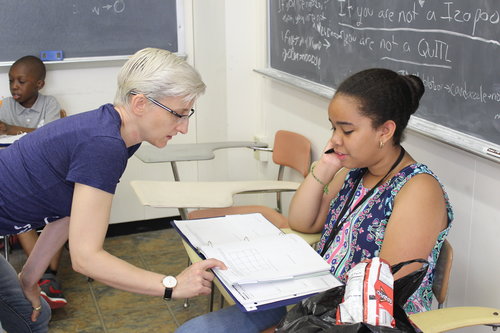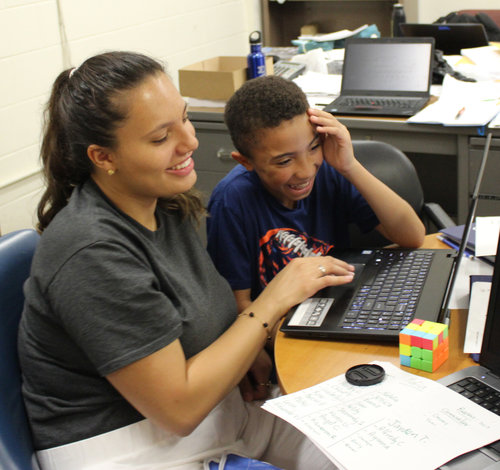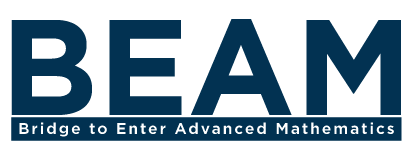BEAM Discovery Faculty Info
This page contains information about working at BEAM Discovery, our non-residential program in New York City and Los Angeles. We also hire faculty at BEAM Summer Away, our residential program in the Hudson Valley and Southern California.
This position is intended for those with work experience beyond college, including a post-graduate degree, a college degree, or equivalent experience. For current college students, please apply to be Counselor/TAs at our programs.
This summer, change the lives of students with exceptional potential from underserved schools: help them open their minds to new areas of mathematical study and awaken a love of mathematics. BEAM, a project of the Art of Problem Solving Initiative, Inc., is seeking instructors for a summer day camp that gives underserved students a chance to excel in mathematics. Our math day camps run for 5 weeks over the summer in both Los Angeles and New York City, and full-time instructors teach two classes for all 5 weeks.
Please click on the headings below to learn more about the BEAM Discovery program, the faculty position, and the application process. If you’re ready to apply and have further questions, check out our FAQ page. We look forward to hearing from you!
+ About the Program

BEAM Discovery is the earliest opportunity for students to attend a BEAM program: a five-week nonresidential summer camp for rising 7th graders. We create a life-changing experience for our students, both academically and non-academically, where they'll be in a community of peers interested in mathematics for perhaps the first time in their lives. We supplement the social environment with activities, field trips, guest lectures, and more.
BEAM has served the New York community since 2011, and Los Angeles since 2017. As far as we know, nothing quite like this exists elsewhere: while many efforts in underserved communities focus on achieving minimum competency or basic exposure to STEM, we focus on advanced math from an early age. Our experience has been that the program really changes lives and serves as a model for outreach across the country, while expanding the talent pool for mathematics and related fields.
+ About the Students
Our students are bright and motivated students who lack sufficient challenge at their existing schools. They are excited to be here and ready to learn, but they may not have the mathematical background of other students who have had more regular access to enrichment.
Students are selected for a combination of insight on challenging math puzzles, teacher nominations, and demonstrated interest and motivation. Many will be the top math students at their schools; a few will be "wildcards" within whom we hope to light a spark — students who might be less motivated in a traditional classroom setting but who showed promise on our problems.
In many cases, students' mathematical educations will have been procedural and rote. As a result, math can feel like jumbled facts to them rather than a coherent subject, and they may lack understanding of topics you consider elementary.
+ Your Role
As faculty, your role is to guide students as they discover new fields of mathematics. Our classes are small and highly interactive. Each class generally has around 15 students, and you will have a teaching assistant (either in college or a high school BEAM alum) to assist, allowing for a high degree of personalization.
You may teach either one course or two, so long as they do not conflict. Logical Reasoning and Math Fundamentals are offered in the morning (usually around 9:20am-10:20am), while Creative Problem Solving and Applied Math are offered in the afternoon (usually around 1:05pm-2:05pm), and each is followed by an hour of Open Math Time, which you stay for (see below for more information on classes and Open Math Time). Thus, you have the flexibility to have short days or to really dive into the program. See below for an example schedule for someone teaching two classes. Please note that the details of the schedule differ slightly by location.
Over the course of the program, each class is replaced 1-2 times during camp with a "math circle" or other activity run by a visitor. Your responsibility during this time instead of staying with your class is to visit other classes to see how other classes at BEAM are taught. (It's important to us that everyone, student and staff alike, are learning!)
A note on what we're looking for
We seek individuals who have a depth of mathematical expertise, good pedagogical style, classroom management skills, and the potential to be a role model. Our courses are about understanding mathematics on a deep level rather than procedures, and we're looking for teachers who can create classes that reflect this. Furthermore, we are looking for staff members who can reflect and seek personal growth, for our students, themselves, and the entire program.

+ Details of the schedule and time commitment

Your detailed responsibilities and expectations are:
- Before the program:
- Some paperwork and pre-programming training. We’ll ask you do some both program-related information (what classes you’re teaching, some video-training) and some employment paperwork (a doctor’s note, signing up for our payroll system, etc.).
- Prepare your courses. Although you will have some time once the program begins, our instructors report that having most of their material developed ahead of time is very helpful
- Attend 3-day training before students arrive.
- During the program:
- Teach each class to two cohorts of students (alternating days) and stay for Open Math Time following the classes you teach (see below for more information on our classes and schedule).
- Communicate with your TA about the course: send them a brief overview of each day's topic and what their role will be. Note that TAs may not have much time to prepare before the class itself, but it is important to us that the TAs have positive experiences and learn about teaching.
- Schedule a weekly meeting with your TA to briefly discuss how the class is going, individual students, and what you plan on covering in the future (we suggest at least 30 min each time).
- Assign and review student problem sets.
- When your class is replaced by a math circle, visit other classes (and, ideally, offer to discuss the class afterward with its teacher).
- Attend two one-hour staff meetings per week. The exact timing of these differs by location, but these are commonly Tuesdays and Fridays.
- At the end of the summer:
- Write a paragraph for each student about their progress in the class.
- Provide private feedback on each student to be used internally by BEAM.
- Attend a day of wrap-up after the end of the summer.
In general, we want our staff to be informal mentors for the students. You are welcome (and encouraged!) to stay for meals and social events to get to know the students on a personal level (we run sports, arts and crafts, dance, karaoke, board games, and much more), although this is entirely optional. (We also aim to build a community among our staff as well as among students, and so we host weekly staff dinners to allow you to meet other teachers and counselors at the program.)
We stay on a first-name basis with the students, and you will get to know the students well, and form close bonds with many of them. These connections are often some of the most valuable things students draw out of their summer. They're a wonderful group of kids, eager to learn, often without the opportunity to do so at this level, and we think you'll be as excited as we are to lead them on this journey.
Sample schedules
To give you a sense of the time commitment, here are two samples of what a schedule might be like, both for someone teaching two classes (although you can choose to teach one class).
Sample schedule:
| Monday | Tuesday | Wednesday | Thursday | Friday | |
|---|---|---|---|---|---|
| 9am-9:15am | (Optional) Breakfast with students | ||||
| 9:20am-10:20am | Teach Math Fundamentals Cohort A | Teach Math Fundamentals Cohort B | Observe other teachers | Teach Math Fundamentals Cohort B | Teach Math Fundamentals Cohort A |
| 10:20am-11:15am | Work with students during Open Math Time | ||||
| 11:20am-12:20pm | (Optional) Activity with students | Staff Meeting | (Optional) Activity with students | Staff Meeting | |
| 12:25pm-1pm | (Optional) Lunch with students | ||||
| 1:05pm-2:05pm | Teach Applied Mathematics Cohort C | Teach Applied Mathematics Cohort D | Teach Applied Mathematics Cohort C | Teach Applied Mathematics Cohort D | Teach Applied Mathematics Cohort C |
| 2:10pm-3:05pm | Work with students during Open Math Time | ||||
| 3:05pm-4:05pm | (Optional) Activity with students | ||||
+ Academics and Classes
The Classes
Faculty have the choice of either teaching a course using one of our pre-packaged curricula based on classes that have been successful at BEAM in the past or creating their own curriculum within the broad goals of the program (click through the links below to learn more about these goals). There are four topic areas of classes, each offers different classes, and each student chooses one course from each of:
- Logical Reasoning introduces logical reasoning including deductive logic, case analysis, working methodically, and proof by contradiction. Students are first introduced to puzzles such as Sudoku or Ken-Ken, liar/truthteller puzzles, or "matching riddles". Having gained basic skills in these puzzles, they transition to using those skills on mathematical problems.
- Math Fundamentals covers mathematics from school, but leads students to understand mathematics without relying on memorized procedures.
- Creative Problem Solving exposes students to problems that require creativity, such as those in math contests (for example, from MATHCOUNTS). Most Creative Problem Solving courses cover a specific topic area such as number theory (focusing on prime factorization), combinatorics (focusing on the multiplication principle), or geometry, although there is flexibility for other models.
- Applied Math introduces students to different areas of work related to mathematics. Examples include programming, astronomy, mathematical biology (such as predator and prey models, or genetics), or estimation and Fermi problems.
The Class Structure
Students take two hour-long classes each day on an A/B alternating schedule. So each course meets every other day, and students take a total of four courses (one from each topic area below) throughout the summer. For faculty, each course you teach will have two sections with different cohorts of students, which alternate days, and thus you'll teach every day. In total, each course has 11 class hours. (See below also for a sample weekly schedule.)
Open Math Time
One of the most important periods of each day’s schedule is Open Math Time, when students do independent work on problem sets from class, challenge problems, or other math of their own choice. There is an hour-long block of Open Math Time following each class period, and as faculty, you will assist students in your classes during that time. We believe strongly in facilitating student initiative and choice, both through Open Math Time and also by allowing them to choose courses.

+ Salary and other details
In an effort to provide entry points for people at multiple stages of their careers, we have introduced junior faculty positions in addition to our faculty positions. Teaching responsibilities are similar, but junior faculty engage in additional mentoring and support (see below for details).
Faculty Positions
In the application, we expect faculty to demonstrate a more independent ability to plan and manage their own classes, as well as (where appropriate) the expertise needed to plan their own curriculum. Faculty positions are especially intended for:
- University professors, especially those with outreach experience,
- Middle or high school teachers with strong mathematics backgrounds and 3+ years of experience, or
- Graduate students in mathematics or related fields who have prior K-12 teaching experience.

We strongly welcome applicants in applied fields as well as those in mathematics. Computer science, astronomy, and genetics have all been part of our program in the past, so long as substantial mathematical reasoning was involved in the courses.
We strive to pay our faculty well for their time, but we hope that you will see the program as we do: a labor of love that gives kids access to great mathematics. Please refer to the information in the job description posted online for compensation information.
Junior Faculty Positions
Junior faculty have the same responsibilities as faculty, although they enter into a mentoring program guided by experienced BEAM instructors, and attend our course planning retreat.

Junior faculty positions are intended for:
- Graduate students in mathematics or related fields, especially those with outreach experience,
- Early career middle or high school teachers with strong mathematics backgrounds and less than three years of teaching experience, or
- Other professionals with limited teaching experience.
We expect Junior Faculty to teach two courses, but please contact us if you are interested but can only teach one. After two or three years of experience with BEAM, Junior Faculty are often invited back to be full faculty.
We strive to pay our staff well for their time, but we hope that you will see the program as we do: a labor of love that gives kids access to great mathematics. Returning staff receive higher salaries based on the number of summers they have attended. Please refer to the posted job descriptions for more specific compensation information.
+ FACULTY RECRUITMENT PROCESS
OVERVIEW OF THE PROCESS
In the interest of transparency, we’ve laid out the steps of our hiring process below, but you’re also welcome to skip directly to the application via the button at the top of this page.
- The first step is the initial application to learn more about you as a teacher, gauge your fit with the program, and collect basic information. You will be asked to submit a resume as part of your application, but feel free to substitute a CV or brief summary of your experience. Please do not spend too much time on this; it should take no more than an hour to submit. If you have questions or would like to share any supplemental documents, feel free to reach out at hiring@beammath.org.
- Once we have reviewed your initial application, we may invite you to an initial 30 minute interview where we can learn more about your approach to teaching and you can ask questions about the program
- After that interview, we may invite you to submit a more detailed course proposal. This is the most important component of your application.
- If you are applying to teach a pre-packaged course, we will give you a class to review beforehand and perhaps ask you to submit some problem solutions from that class.
- If you are applying to teach your own class, we will be doing the interview based on the course proposal you submitted and asking more in depth questions about it.
- Once we have reviewed your material, the final step of the process is an interview of about 60 minutes. We try to keep the interview relaxed, but do plan to have a serious conversation about curriculum, mathematics, and class management.
We are dedicated to putting together the staff that can put together the best possible experience for our students, and believe that this process gives us valuable information on this. We appreciate and value your work and time, and if there is anything we can do to clarify or improve this process for you, please do not hesitate to reach out to hiring@beammath.org.
*Note sure which is the right fit? Apply to only one and note it in your application —- we can transfer you between positions.
*
We will continue to accept Faculty applications and review on an ongoing basis.
Additional Notes
We welcome applications from anyone who think they might be a match for our program. If you're wondering if you're a good fit for the program, please contact us at hiring@beammath.org to discuss your background.
We aim to provide strong role models for our students, and that means finding an instructional faculty that shares the background of our students as much as possible. Thus, we especially encourage applicants who come from underrepresented minority groups, applicants who have faced financial hardship while pursuing their education, and/or applicants who have experience in the New York City or Los Angeles public school system. We are an equal opportunity employer, and so persons of color, women, and those with disabilities are all encouraged to apply. Showing diversity in mathematical achievement is critical to our program's success.
Please note that if you do not live in New York City or Los Angeles, you must have your own housing for the summer (we cannot provide it, although the salary is more than sufficient to arrange housing if needed). We do provide housing for BEAM Summer Away Faculty and if it seems more appropriate, then we encourage you to apply for those roles instead!
Supplies
We have a budget to purchase needed class supplies, as well as (low-cost) books for students to work out of. For example, you might want to teach a Logical Reasoning course out of a Raymond Smullyan book, or get Art of Problem Solving books for Creative Problem Solving. We also can get a license for Mathematica, or other software (within reason).
All students are provided with the material they need to participate.

We are always available to answer any questions you might have, so please feel free to get in touch. We look forward to working with you this summer!
Sincerely,
Javier Ronquillo Rivera, Ph.D.
Math and Pedagogy Lead
javier@beammath.org
Josephine Ochoa
Director, LA Programs
josephine@beammath.org
Cynthia Correa
Director, NY Programs
cynthiac@beammath.org
Sarah Yoseph
Manager, Math Instruction, Los Angeles
syoseph@beammath.org


